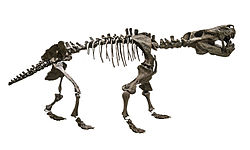
Back إنوسترانسيفيا Arabic Иностранцевии Bulgarian Inostrancevia Catalan Inostrancevia Czech Inostrancevia German Ινοστρανσέβια Greek Inostrancevia Spanish اینوسترانسویا Persian Inostrancevia Finnish Inostrancevia French
| Inostrancevia | |
|---|---|

| |
| Mount cast of one of the first two described skeletons of I. alexandri (PIN 1758), exposed at the Museo delle Scienze, Trento, Italy | |
| Scientific classification | |
| Domain: | Eukaryota |
| Kingdom: | Animalia |
| Phylum: | Chordata |
| Clade: | Synapsida |
| Clade: | Therapsida |
| Clade: | †Gorgonopsia |
| Family: | †Gorgonopsidae |
| Subfamily: | †Inostranceviinae |
| Genus: | †Inostrancevia Amalitsky, 1922 |
| Type species | |
| †Inostrancevia alexandri Amalitsky, 1922
| |
| Other species | |
| |
| Synonyms | |
|
List of synonyms
| |
Inostrancevia is an extinct genus of large carnivorous therapsids which lived during the Late Permian in what is now European Russia and Southern Africa. The first-known fossils of this gorgonopsian were discovered in the context of a long series of excavations carried out from 1899 to 1914 in the Northern Dvina, Russia. Among these are two near-complete skeletons embodying the first described specimens of this genus, being also the first gorgonopsian identified in Russia. Several other fossil materials were discovered there, and the various finds led to confusion as to the exact number of valid species, before only two of them were formally recognized, namely I. alexandri and I . latifrons. A third species, I. uralensis, was erected in 1974, but the fossil remains of this taxon are very thin and could come from another genus. More recent research carried out in South Africa and Tanzania has discovered specimens identified as belonging to this genus, with the South African specimens being classified within the species I. africana. The whole genus is named in honor of Alexander Inostrantsev, professor of Vladimir P. Amalitsky, the paleontologist who described the taxon.
Possessing a skull measuring approximately 40 to 60 cm (16 to 24 in) long depending on the species, all for a body length reaching 3 to 3.5 m (9.8 to 11.5 ft), Inostrancevia is the largest known gorgonopsian, being rivaled in size only by the imposing Rubidgea. It has a broad and elongated skull equipped with large oval-shaped temporal fenestrae. It also has very advanced dentition, possessing large canines, the longest of which can reach 15 cm (5.9 in) and which may have been used to shear the skin of prey. Like most other gorgonopsians, Inostrancevia had a particularly large jaw opening angle, which would have allowed it to inflict fatal bites. Gorgonopsians in general would have been relatively fast predators, killing their prey by delivering slashing bites with their saber teeth. The skeleton is robustly constructed, but new studies are necessary for a better anatomical description and understanding about its paleobiological functioning.
Gorgonopsians were a group of carnivorous stem mammals with saber teeth that disappeared at the end of the Permian. The first classifications placed Inostrancevia as close to African taxa before 1948, the year in which Friedrich von Huene erected a distinct family, Inostranceviidae. Although this model was mainly followed in the scientific literature of the 20th and early 21st centuries, phylogenetic analysis published since 2018 consider it to belong to a group of derived Russian origin gorgonopsians, now classified alongside the genera Suchogorgon, Sauroctonus and Pravoslavlevia, the latter and Inostrancevia forming the subfamily Inostranceviinae. Russian and African fossil records show that Inostrancevia lived in river ecosystems containing many tetrapods, where it appears to have been the main predator. These faunas were mainly occupied by dicynodonts and pareiasaurs, which would most likely have constituted its prey. In the Russian territory, Inostrancevia would have been the only large gorgonopsian present, while it would have been briefly contemporary with the rubidgeines in Tanzania. When the rubidgeines disappeared from South African territory, Inostrancevia would have in turn occupied the role of apex predator before disappearing in turn during the Permian-Triassic extinction.
- ^ Kukhtinov, D. A.; Lozovsky, V. R.; Afonin, S. A.; Voronkova, E. A. (2008). "Non-marine ostracods of the Permian-Triassic transition from sections of the East European platform". Bollettino della Società Geologica Italiana. 127 (3): 717–726.
- ^ Cite error: The named reference
Kammereretal2023was invoked but never defined (see the help page).